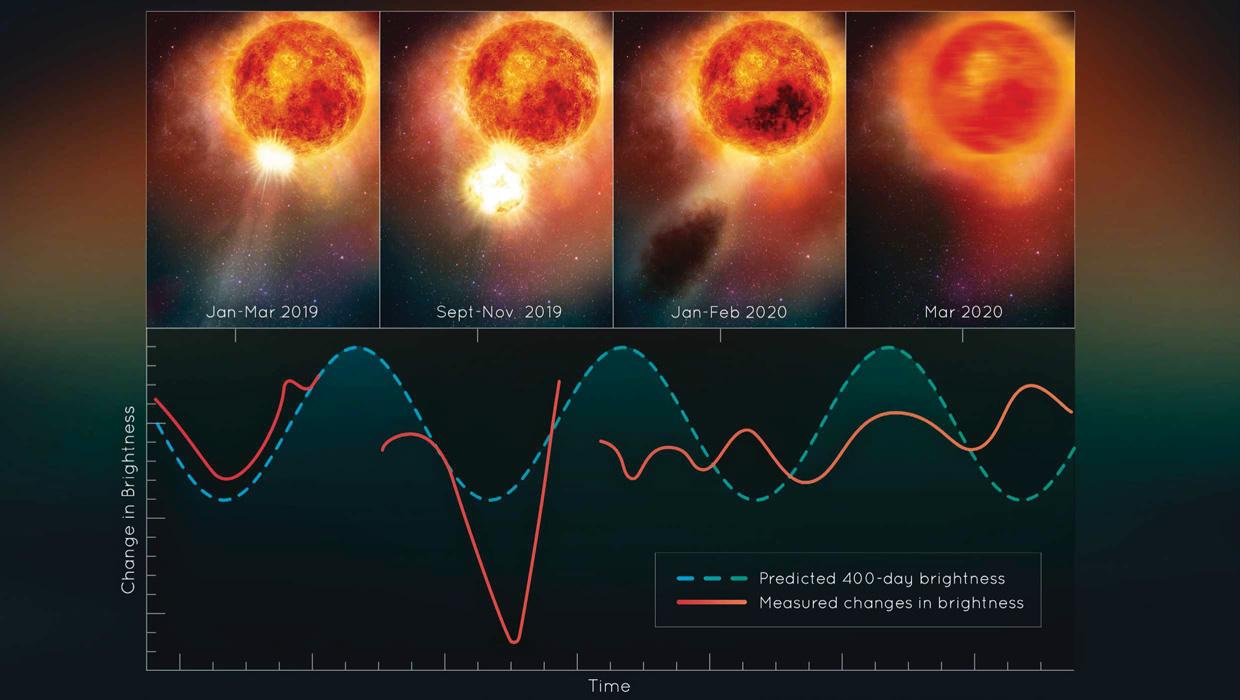Betelgeuse's spectacular blow-out
BBC Sky at Night Magazine
|October 2022
A mass ejection larger than the Moon caused the star's dimming in 2019
-

Three years ago, amateur astronomers around the world watched as the usually bright light of Betelgeuse dimmed overnight and remained that way for several months. Now a group of astronomers have determined it was caused by a piece of the star's atmosphere being ejected into space.
"We've never before seen a huge mass ejection of the surface of a star," says Andrea Dupree from the Center for Astrophysics, Harvard and Smithsonian, who led the study.
Betelgeuse is a red giant star over 1.6 billion kilometres wide - meaning if it replaced our Sun it would swamp Jupiter and almost reach Saturn. It has ballooned in size as it is approaching the end of its life and will eventually go supernova.
Though this is unlikely to happen for the next 10,000 years, it gives astronomers a unique view of a star in its final centuries. Over 200 years of observations have shown that the star's brightness slowly pulses according to a 400-day cycle, but the scale and speed of the 2019 dimming was unprecedented.
Drawing together observations from all over the world, Dupree has determined that material bubbling up within the star blasted off a piece of the photosphere. The ejection had a mass several times that of our Moon - a colossal 400 billion times more than what our Sun typically gives off during coronal mass ejections. As this fractured piece cooled, it formed a dust cloud that blocked Betelgeuse's light from Earth, causing it to appear dimmer.
It also appears that Betelgeuse's 400-day brightness cycle has stopped, or at least paused. Spectral Hubble observations taken by Dupree showed signs that this event and the star's attempts to rebuild its photosphere have disrupted the internal motions that drive the cycle.
Denne historien er fra October 2022-utgaven av BBC Sky at Night Magazine.
Abonner på Magzter GOLD for å få tilgang til tusenvis av kuraterte premiumhistorier og over 9000 magasiner og aviser.
Allerede abonnent? Logg på
FLERE HISTORIER FRA BBC Sky at Night Magazine

BBC Sky at Night Magazine
MOONWATCH
January's top lunar feature to observe
2 mins
January 2026

BBC Sky at Night Magazine
Speed up your processing workflow
How to use Photoshop's Actions tool to drastically cut your processing time
3 mins
January 2026

BBC Sky at Night Magazine
Chasing Canada's polar lights
With solar maximum peaking and a new Moon promising dark skies, Jamie Carter travels to Churchill, Manitoba to hunt the Northern Lights - and dodge polar bears – in Canada's far north
7 mins
January 2026

BBC Sky at Night Magazine
Beyond Pluto: The search for the hidden planets
Could one – or even two - undiscovered planets lurk at the edges of our Solar System? Nicky Jenner explores how close we are to finding the elusive 'Planet 9'
6 mins
January 2026

BBC Sky at Night Magazine
Jupiter moon events
Jupiter is a magnificent planet to observe.
2 mins
January 2026

BBC Sky at Night Magazine
What samples from space have taught us
Alastair Gunn explains what scientists have learnt in the 20 years since the first unmanned mission brought materials back from alien worlds
3 mins
January 2026

BBC Sky at Night Magazine
The Milky Way as you've never seen it before
This is the largest low-frequency radio colour image of our Galaxy ever assembled
1 min
January 2026

BBC Sky at Night Magazine
Merger of ‘impossibly' massive black holes explained
Scientists discover how enormous, fast-spinning black holes can exist after all
1 mins
January 2026

BBC Sky at Night Magazine
Lunar occultation of the Pleiades
BEST TIME TO SEE: 27 January from 20:30 UT
1 min
January 2026

BBC Sky at Night Magazine
The Universe's expansion may be slowing down
New study suggests current theories of dark energy could be wrong
1 mins
January 2026
Translate
Change font size

